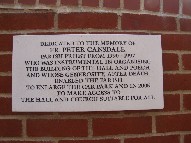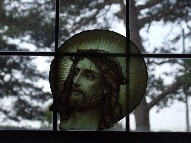| |
|
Our Lady
of Refuge, Cromer
 |
|
As
I have already observed on the entry for the
Catholic church at Sheringham a few miles off, it
is hard to conceive that, in these days when the
Catholic church provides the largest single body
of worshippers in England, the north coast of
Norfolk had not a single worshipping Catholic
community at the time of the 1851 census of
religious observance. And, as I have also
observed elsewhere, I always think that it must
be difficult for English Catholic congregations
to step out of their often small, undistinguished
churches, into the shadow of the huge medieval
churches that were once in their care. Catholic
Priests ministered to the parish churches of
England until the final break with Rome in 1557,
but after that they fell into the care of the new
protestant Church of England, and celebrations of
the Catholic Mass became punishable by death. And
yet, the glory that is St Peter and St Paul, the
vast medieval church in the middle of Cromer, is
out of sight to the Catholic worshippers here,
because when Our Lady of Refuge, the first proper
post-Reformation Catholic church in the area
since the Reformation, was built at Cromer in
1886, there was such virulent opposition in the
town that it had to be built out in the suburbs
on the road to Overstrand. It is aptly dedicated. |
Of course, many other countries
experienced the Reformation, or religious discords of
their own kind, even wars, but only England sees its past
refracted through the puritan fire of the 17th century.
England is a nation which, for much of its early modern
history, was virulently, even pathologically,
anti-Catholic. In some quarters, suspicion remains even
today. Be that as it may, the return of the Church to the
north of Norfolk coincided with the rise of mass tourism
in what was known as Poppyland. The railways opened the
coast up to holidaymakers, and the big hotels were built
to accomodate them. It was a radical change for these
introverted parishes, which still seem so remote from
London, barely 150 miles away. When the church
was built, there was no resident priest at Cromer. The
Diocese of Northampton provided a priest in the summer
for the benefit of holiday makers at the request of
Clement Scott, the inventor of Poppyland, and developer
of the holiday industry in this part of Norfolk. The
priest, from the church of St John the Baptist in
Norwich, now the Cathedral, would arrive by train to say
Mass, but in 1902 the increase in population led to
Cromer, and thus north Norfolk, having its first resident
Catholic parish priest for almost 450 years.
| As the Catholic church has
grown in England, so the earlier churches have
had to be replaced or greatly expanded. Nowhere
is this more obvious than here at Cromer, where
the 1886 church survives as the kernel of a great
agglomeration of later extensions. The most
recent of these was in the 1990s, when the hall
and porch were added. Our Lady is a sister church to Giles
Gilbert Scott's spectacular church of St Joseph
at Sheringham, with which it now forms a joint
parish. In comparison, Our Lady is rather homely,
even rustic. If it wasn't for the sign, you might
not even recognise it as a church. Inside the
red brick structure, the walls are painted Marian
blue, the furnishings apparently acquired from
two or three different sets. The post-Vatican II
sanctuary is sparse and simple in comparison with
that at Sheringham, but it contributes to the
feeling of a light and loved interior, a suitable
setting for the sacramental work of the church. A
refuge indeed.
|
|
 |
|
|
|
